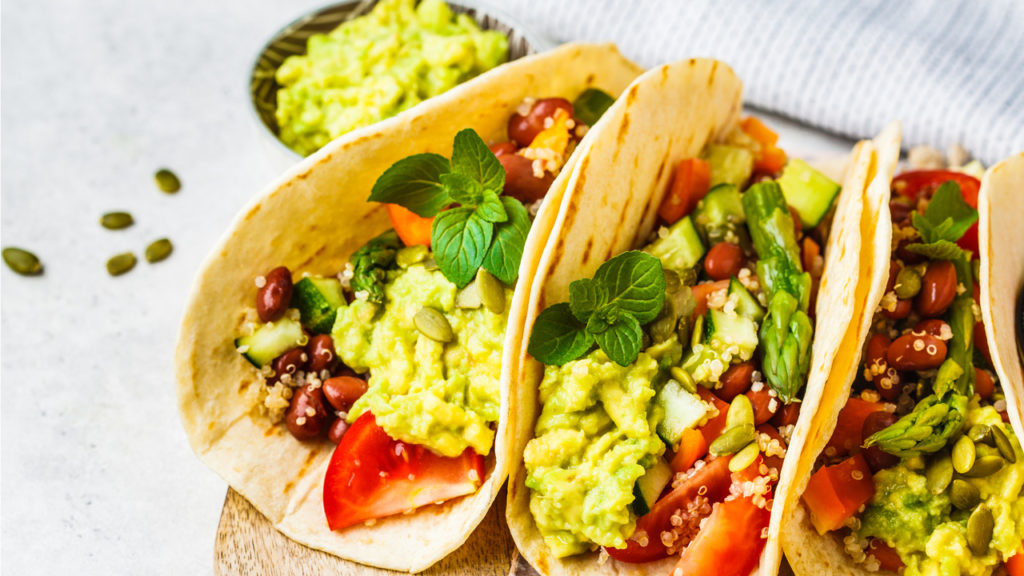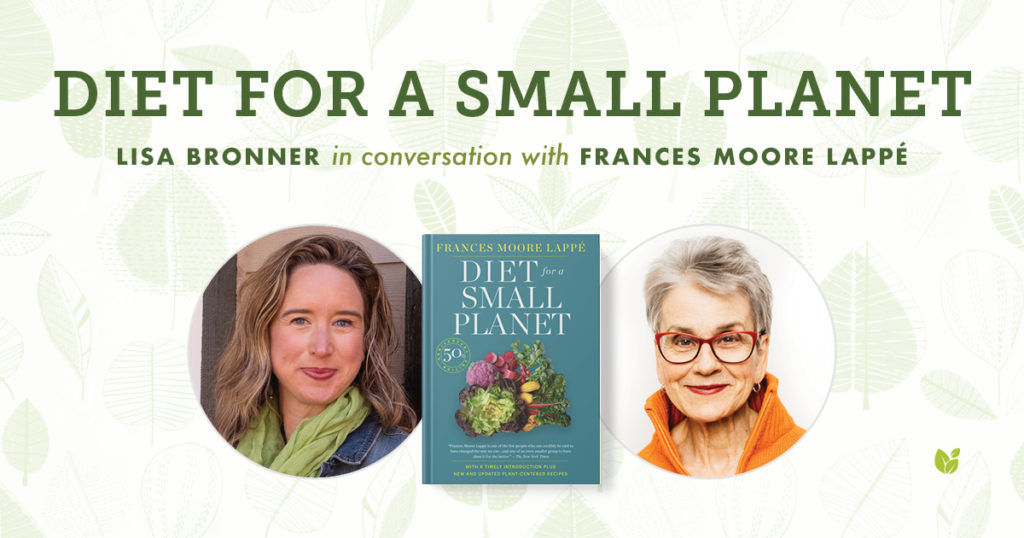
Getting more plants – fruits, veggies, legumes – onto our plates and into our bodies is a good thing. I’m going to leave the “why” on that statement to the 1.6 billion results that just came up when I Googled the question.
Regardless of the extent of your plant-eating aspirations – whether it’s just more of your plate, or most of your plate, a vegetarian variation, or all the way to vegan – let’s look at ways to get more of that healthiness inside us.
For me, I aspire to Michael Pollan’s exhortation: Eat Food. Mostly Plants. Not too much. Even without looking, I can still recall the nuggets from his book Food Rules, in which he elaborates:
- Don’t eat anything your great grandmother wouldn’t recognize as food. (My mind always pictures gummy bears.)
- Eat food that comes from plants, not food that was made in a plant.
- Eat your food sitting down at a table – your desk doesn’t count. (That hits me where it hurts!)
- Don’t buy your food at the same place you buy your gasoline.
- Get your snacks from the Farmer’s Market. (Or that could be bought at the Famers Market.)
- Drink the spinach water. (Um, what now? Oh! Soup! Put it in soup. Got it.)
Although my family ate lots of fruits and veggies growing up, my brother David’s switch to veganism after college took things to a whole new level. Can a 6’5” 20-something year old actually live only on fruits and vegetables? Judging by current realities, yes. He’s CEO of Dr. Bronner’s to this day. His switch made me explore how vast, varied, and satisfying plant-based eating can be.
I remember one Christmas that my brother Mike was making a complicated mushroom dish. Several of us jumped in to help him, working through the elaborate recipe. When we were nearly done, he said, “So this is for David.” At which we all raised a hullaballoo because the mushroom dish looked and smelled AMAZING. There was no way this was “just for the vegan.” It was unqualifiedly delicious and we all enjoyed it. Plant-based is no drawback.
It’s been fun to watch the change in food availability when it comes to plant-based options. I’ve been going to Expo West, the nation’s largest natural products trade show, since the days when it was a bunch of crunchy hippies with their crunchy wares earnestly displayed on 6-foot tables. My grandfather and his oddly bottled soap fit right in. The tradeshows were mellow and exceedingly interesting. When plant-based eating started to gain some traction, there was soy as far as the eye could see at Expo West. Every animal-based food had a soy-based alternative. Yogurt, hotdogs, cheese, ice cream, chicken nuggets. And so after spending the day sampling from table to table, at the end of the day I’d realize all I’d eaten was soy. It was an inauspicious beginning. And I had a stomach-ache.
But since then, plant-based foods have soared in variety and quality. From cultured vegan butters to vegan mayonnaises to gorgeous meltable vegan cheeses, the taste of plant-based alternatives has improved tremendously as has the variety of ingredients.
But better than that, the initial understanding that plant-based eating meant recreating animal-based foods from plants has diminished. Instead, there is far greater appreciation of plants on their own, without any sort of animal disguise. Plus, food science has progressed to show us that in plants, we can find complete nutritional profiles.
The influx of gorgeous plant-based menus, the increase in availability of diverse veggies and fruits, as well as seasonings has elevated plant-based eating in the extreme and made it a delight.
I give a huge shout out to my mom who normalized fruits and vegetables for me. I especially remember her salads. Elaborate salads at dinner were common. My mom would wash and tear lettuce, slice mushrooms, cucumbers, tomatoes, carrots, beets. As an adult, I now appreciate how much time that all took. In comparison, I’m downright lazy when it comes to salads with my measly sprinkle of nuts and cranberries. And I recall at least two other veggies at every meal. The fruit bowl was always full of apples, oranges, peaches, plums, pears, grapes.
But I certainly went through some plant desert days once I was out on my own. Even now, I sometimes get in a low-plant rut. Here are a few tips that I’ve adopted to get myself back in gear.
19 Hacks to Boost Your Plant Eating
- Take it one step at a time. If you eat meat three meals a day, one step would be dropping down to two. If you eat meat, twice a day, try dropping down to one. If once a day, try a meatless day.
- Cook. Amongst the bountiful benefits of cooking, here I’ll mention that when you cook your own food, you can incorporate so much more variety of fresh fruits and veggies. If cooking is not your thing, go back to tip #1: one step at a time. Increase your homecooking bit by bit – one more meal a week, one more meal a day.
- Cook big and freeze. Make your meals do double-duty by cooking larger amounts of those plant-paloozas and freezing meals for busy nights. Chilis, pasta sauces, breads, taco fillings all excel at being frozen.
- Swap it. Substitute coconut oil or vegan butter (Miyoko’s cultured butter is my fav) for dairy butter. Vegan mayonnaise for regular mayo. A tahini dressing for a ranch.
- Leave it out. I’ve found that there are many dishes I thought were meat-centered that actually work just fine without it. Burritos, tacos, sandwiches, stir-fries, bean soups, chili all have so many other ingredients that the meat is hardly missed.
- Move meat to the side. If you can’t do without it (yet), make it the seasoning instead of the centerpiece of the dish. In stir-fries, soups, pizzas, you can umph up the veggies and pare down the meat.
- Eat at least one fruit or veggie at every meal or snack. Somewhere I picked up the wisdom, “If you’re not hungry enough to eat an apple, you’re not hungry.” Always a good test on whether I’m eating out of boredom or habit instead of actual hunger.
- Eat beans. Orange lentils, deep red kidneys, black turtles, bright white Northerns, green split peas, beans are as gorgeous as they are cheap, tasty, versatile, and filling. Whenever I hear someone wonder how they can get filled up without meat, I point them to beans.
- Eat the rainbow. As ethereal as that sounds, I mean it literally. Red strawberries, orange squash, yellow sweet peppers, green chard, blueberries, purple potatoes. Different colors signify different nutrients, so when you eat foods of varying color, you’re giving your body a wide swath of nutrient tools to work with. And it’s a fun way to present it to kids!
- Be adventurous! Maybe not all the time every day. But maybe once a week, try a new fruit or vegetable or recipe. To my great surprise, I discovered as an adult I really like Brussels sprouts, roasted with olive oil, salt, and pepper – see next tip – and drizzled with a balsamic glaze. They say it takes eight encounters to accept a new food, so don’t dismiss them too quickly.
- Olive oil, salt, and pepper. My go-to veggie prep is to toss them with olive oil, salt, and pepper, and roast them in the oven at 425ºF. Great for cauliflower, beets, asparagus, sweet potatoes, white potatoes, squash, broccoli, onions, bell peppers. This is how you make kale chips, too, but lower the oven to 375ºF.
- Try the veggie option. When you’re eating out, try the veggie sandwich, the vegetarian pizza. Marinara sauce instead of Bolognese. A burger of portobello mushroom or black bean or quinoa. No, it won’t taste like meat – nor should it. It has its own kind of deliciousness.
- Join a CSA. CSA = Community Supported Agriculture. Aka farm boxes. It’s a box of fresh, local, in-season produce, and supports a local farmer. The food in these boxes per item are super budget-friendly. Plus, I know for me, if I have the food, I’m much more likely to eat it. Which leads me to…
- Prep fruits and veggies when you’re not hungry. Hunger = impatience, and when we’re impatient, we’re not going to take the time to cut up carrots. At least I’m not. I’m going to grab something that’s easy, and comes in a package and is likely highly processed. After dinner, make a salad for tomorrow’s lunch. Cut carrots and the celery at breakfast for easy snacking through the day. Set yourself up for success by making things grabbable.
- Set out fruit and veggies as appetizers. Is it just in my house? As soon as I step foot in the kitchen to start making dinner, the hordes descend, famished. I appease them by setting out sliced apples, carrots, broccoli, hummus that they can snack on while they wait. They’re eating the healthy stuff when they’re hungriest. And hunger is, after all, the very best seasoning.
- Save the veggie scraps to make broth. Put a container in your freezer and throw in your broccoli stalks, carrot tops, onion skins, squash peels. When full, dump the contents into a pot, cover with water, maybe throw in a tablespoon of salt and your favorite herbs, and let it simmer for an hour or more. Cool and strain. Use for soups or rice and freeze what’s leftover. You’re saving money by using something you’d otherwise be tossing, and you’re getting more nutrients and flavor into your food.
- Have some catch-all dishes. These are dishes that use up lots of miscellaneous fruits and veggies. For me they’re smoothies, stir-fries, salads, soups, pizzas, tacos. These six can make use of whatever’s languishing in the crisper. My main go-to are the soups. I haven’t met a veggie that can’t go into a soup.
- Spice it up. My Black Bean Soup is my kids’ favorite. What they don’t know is that it’s never the same twice, because I’m always adding whatever I find in my veggie drawer – leafy greens, squashes, radishes, squash. It’s the seasonings they recognize – cumin, oregano, thyme, garlic, bay leaf. Get your base seasonings right, and you can add in just about anything.
- Italian? Oregano, garlic, basil, rosemary, thyme, marjoram.
- Curry? Cumin, coriander, turmeric, cardamom, cinnamon, cayenne.
- Taco? Chili powder, garlic, oregano, cumin, cayenne, black pepper.
- Grow it. Growing food yourself connects you with what you eat. Even if all you can grow is a potted herb – though nearly every veggie can grow in pots. Not only is there a pride in growing something, home-grown food is tastier, harvested when fully ripe rather than in preparation for a journey to market. If you’ve ever had a homegrown tomato or carrot, you know what I mean.
Resource: A Diet for a Small Planet
I recently had the joy of talking with the woman dubbed the godmother of plant-based eating, Frances Moore Lappé. In 1971, Frances published a landmark book, Diet for a Small Planet, overflowing with reasons a plant-based diet is good for body and planet. In fact, you’ll hear her call it planet-based eating, as much as plant-based. It’s both.
With this book, she jumpstarted the cultural conversation that has become a movement. When I mentioned it around the office, my colleague Nichole showed me her first edition copy.

Now that’s a well-used book!
Rereleased with a gorgeous 50th anniversary cover, updated research, and fresh new recipes, her book addresses every hesitation when it comes to eating more plants and tons of recipes for how to boost your plant-eating journey. Her recipes are simple, but can be fancified if you’re so inclined. If someone in your life is vegan or vegetarian or working on it, this is a great book to find common ground – both to read and discuss together and to inspire your dinner table.

I was particularly intrigued in the chapter that tackles protein myths and the concern that plant-based eating provides insufficient protein. These days, it seems that protein is the darling of food packaging, with grams of protein prominently called out on labels. Frances tackles putting those numbers in a healthier context.
Catch our conversation below. I know you’ll be inspired by her enthusiasm, positivity, and wisdom:
Further Recipes to Tempt and Inspire from My Colleagues
I also turned to another wealth of knowledge: my colleagues at Dr. Bronner’s. (Want to be one? Apply here!) We bond regularly over plant-based food since free daily vegan lunches are one of the many perks of working at Dr. Bronner’s. We even have a food forest woven into the landscaping of our otherwise industrial business park setting. I knew among my coworkers, I’d find lots of passion about plants, so I invited them to share their best plant-based eating tips as well as their favorite recipes that they had personalized.
Here’s some straight from the source Dr. Bronner’s employee inspiration! What variety! What food joy!
And after reading these, I hope you’ll be powered up for some plant-based goodness! My hardship at the moment is deciding which of the below recipes I’m going to make next. Do you see that recipe for coconut bacon??? What?!
By all means, share in the comments your favorite go-to recipes and tips for eating those plants in all their deliciousness. Who knows whom you might inspire!
Lisa’s (yes, me) “Empty the Veggie Drawer” Black Bean Soup Recipe
- 2 lb. dry black beans, sorted and washed
- 1 c. each chopped onion, carrots, celery
- Chopped whatever else is in your veggie drawer – leafy greens, squash, tomatoes, whatever
- 8+ c. veggie broth (to submerge all the above)
- 3 cloves garlic
- 2 Tbsp. tomato paste
- 1 tsp. each oregano, cumin, thyme, pepper (or more to taste)
- 2 bay leaves
- 1 ½ tsp. Smoked Salt, to taste
- 2 Tbsp. lime juice
Directions:
Combine everything except the salt and lime juice in a slow cooker. Cook on low 8-10 hours. To make on a stovetop, soak the beans for an hour, then add the beans and other ingredients into one big pot. Simmer for one hour. Season to taste with salt and lime juice. If desired, smash the mixture with a potato masher to desired consistency. If you make it, I’d love to hear what veggies you added and how you like it.
Brian’s Vegan Spicy Tomato Soup Recipe
- Cooking oil of your choice
- 1 medium-sized onion
- 4 cloves of garlic, chopped
- 1 large Yukon potato, cut into about 1-inch pieces
- 1 stalk celery, chopped
- 1 large carrot, skinned and chopped
- 6oz canned tomato paste
- 12oz fresh or canned diced tomatoes, no salt added
- 1 ½ quarts vegetable broth
- Cream product: 12oz canned coconut milk (preferred!), 1 cup unsweetened plain soy yogurt OR 1 cup coconut cream
- Salt & pepper
- Cayenne pepper
- Fresh basil, chopped
Directions
Set out the cream to come to room temperature. In a 4-quart or larger stockpot, sauté the onion and garlic in oil until the onions are translucent, about 5 minutes. Add in the potato, celery, and carrot. Season with a little salt and pepper. Continue to cook for a few minutes. Turn down the heat to medium-low. Add the tomato paste and cook for a minute. Add the canned tomatoes and vegetable stock. Bring to a simmer. Cover the pot and let simmer for 20 minutes. Turn off the stove. Use an immersion blender to blend the mixture until smooth. If you don’t have an immersion blender, carefully (one cup at a time) puree the mixture in a blender until the soup is smooth. Add the mixture back into the pot and stir in the cream product. Mix well. Add salt, pepper, and cayenne pepper to taste. Serve with a basil garnish.
Dania’s Fideo Seco Recipe
- 1/3 c. plus 3 Tbsp. olive oil, divided
- 1 small shallot or ¼ c. onion, coarsely chopped
- 2 garlic cloves, coarsely chopped
- 2 c. chopped tomato
- 1 (14.5-ounce) can diced tomatoes
- 3/4 tsp. kosher salt, divided
- 1/4 tsp. black pepper
- 3 fresh basil leaves or ¼ tsp. dried basil
- 1 1/2 c. vegetable stock, divided
- 1 tsp. canned adobo sauce
- 7 oz. uncooked medium fideo pasta (such as El Mexicano) or thin spaghetti broken into small pieces
- Garnish: Vegan sour cream, sliced avocado, vegan cheese, fresh cilantro leaves
Directions
Heat 1/3 cup oil in a medium saucepan over medium. Add shallot and garlic; cook, stirring often, until softened, about 4 minutes. Stir in chopped and canned tomatoes. Season with 1/2 tsp. salt and pepper. Stir in basil and bring to a vigorous simmer over medium-high. Reduce heat to low, and simmer, stirring occasionally, until mixture is the texture of marmalade, about 25 minutes.
Transfer tomato mixture to a blender. Add 1/2 c. vegetable stock and adobo sauce. Secure lid on blender and remove center piece to allow steam to escape. Place a clean towel over opening. Process until smooth, about 15 seconds. Season with remaining 1/4 tsp. salt. Measure out 1 1/2 c. tomato sauce: and store remaining tomato sauce for another use.
Heat remaining 3 Tbsp. oil in a deep 11-inch skillet over medium-high until hot. Add fideo; cook, stirring often, until toasted and darkened, about 4 minutes. Stir in reserved 1 ½ c. tomato sauce and remaining 1 cup vegetable stock. Return to a simmer over medium-high. Reduce heat to low, and gently simmer, giving skillet a quarter turn every 2 minutes and repositioning skillet over burner, until liquid is absorbed, and rice is al dente, about 15 minutes, stirring once halfway through and gently pressing noodles into an even layer. (Repositioning the skillet ensures you’ll have an evenly browned and crispy crust on bottom of pan and prevents burning. If needed, gently dig into fideo to check bottom of pan).
Remove from heat, cover, and let steam until noodles are tender, about 5 minutes. Garnish with a drizzle of vegan sour cream, avocado, vegan cheese, and cilantro.
Melanie’s Israeli Couscous and Chickpea Salad Recipe
Modified from Martha Rose Shulman
- ½ red onion, sliced into half rings
- 6 Tbsp. fresh lemon juice, divided
- Salt to taste
- 4 Tbsp. extra virgin olive oil, divided
- 2 c. Israeli couscous, preferably whole-wheat
- 4 c. water
- 1 bunch finely chopped cilantro
- 1 bunch chopped chives
- 2 ounce feta, crumbled
- 4 Tbsp. slivered almonds, lightly toasted @ 350F for 5-7 minutes
- 2 cans chickpeas, drained
- 1 red pepper, diced
- ½ English cucumber
- ½ cup pepperoncini
- ½ c. pickled onions
- 2 tsp. cumin
- ½ c. plain whole Greek Yogurt
- 1 tsp. mild chili powder
Directions
In a small bowl, squeeze 2 tablespoons lemon juice over red onions. Add a generous pinch of salt, mix well, and let sit for 20-30 minutes. Heat 2 Tbsp. olive oil over medium-high heat in a medium saucepan and add the couscous. Stir until the couscous begins to color and smell toasty, 4 to 5 minutes. Add 4 cups water and salt to taste and bring to a boil. Reduce the heat, cover and simmer 15 minutes, or until the couscous is tender. Drain if any liquid remains in the pan. Transfer the couscous to a bowl and add the cilantro, chives, feta, almond, chickpeas, red pepper, cucumber, pepperoncini, and pickled onions.
In a small bowl, mix together the remaining 4 tablespoons of lemon juice, salt, cumin, remaining 2 tablespoons of olive oil, yogurt, and chili powder. Toss with the couscous mixture.
Alissa’s Kale Salad with Pumpkin Seeds & Coconut Bacon Recipe
Kale Salad
- 1 or two bunches of kale (washed, stemmed, chopped)
- ¼ c roasted pumpkin seeds
- ½ avocado (chopped)
- ¼ cup coconut bacon (recipe below)
- ¼ cup of dressing (recipe below)
In a large bowl, toss kale with dressing til coated. Add pumpkin seeds, chopped avocado and coconut bacon and toss well.
Coconut Bacon (adapted from Minimalist Baker)
- 2 cups unsweetened coconut flakes (large flakes)
- 1 tbs melted Dr. Bronner’s Coconut oil
- 2 tbs tamari
- 1 tbs maple syrup or agave
- ½ tsp liquid smoke
- 1 tsp smoked paprika
- ½ tsp black pepper
- ½ tsp sea salt
Mix all ingredients together until the coconut is well coated. Spread coconut on a parchment-lined baking sheet in a single layer. Bake at 325°F for 5-7 minutes. Stir coconut. Bake another 5-7 min. After it has cooked for 12 min start checking on it every minute to make sure it isn’t burning. Remove when it is golden brown and a little crispy. It will crisp up more as it cools.
Also great for sandwiches, salads and snacking!
Kale Salad Dressing
- 1/2 cup nutritional yeast
- 1/2 cup water
- 1/3 cup soy sauce
- 1/3 cup apple cider vinegar
- 2 large cloves garlic
- 1 1/4 cups sunflower oil
Blend water, soy sauce, vinegar, garlic and nutritional yeast. Drizzle in sunflower oil and blend until consistency is a little bit thick.
Mindy’s Braised Greens with White Beans and Parmesan Recipe
- 1/4 cup olive oil
- 1 small fennel bulb, trimmed, cored and small-diced
- 1 small yellow onion, small-diced
- 2 teaspoons minced fresh rosemary or thyme
- 5 garlic cloves, minced
- 1/4 teaspoon red-pepper flakes, plus more to taste
- 10 to 12 oz. escarole, kale and/or Swiss chard, stems removed
- 2 (15-ounce) cans cannellini beans, rinsed OR 1 ½ c. dry cannellini beans, soaked and cooked
- 2 cups vegetable broth
- Kosher salt and black pepper
- 1 tablespoon lemon juice
- 1/2 cup shredded mozzarella (optional)
- 3 tablespoons grated Pecorino Romano or Parmesan, plus more for serving (optional)
- Toasted country bread, for serving
Sauté fennel, onion, and fresh herbs in olive oil with a nice pinch of salt for 6-8 minutes until tender over medium-low heat. Add garlic, pepper flakes, and greens and cook on medium to high heat until greens are wilted and a little braised (brown). Add broth beans and use a wooden spoon to smash some of the beans. Bring to a boil and then simmer for 10 or so minutes. Salt and pepper to taste. Remove from heat and squeeze lemon in. Finely grate the parmesan in, and grate more for serving.
Sharry’s Sister’s Shiitake Ginger Zucchini Noodle Soup Recipe
- 4 medium to large zucchini (spiraled)
- 1 Tbsp. Dr. Bronner’s Coconut Oil
- 2 Tbsp. grated fresh ginger
- 5 c. shiitake mushrooms, sliced
- 1 large onion, chopped finely
- 10 c. vegetable or chicken broth
- 1 c. thinly sliced scallions
- Salt & pepper to taste
Sauté garlic, onions, and mushrooms with coconut oil until softened. Add broth, grated ginger, and zucchini noodles. Cook for 5 mins. Garnish with fresh scallions.
Kimmie’s Flax Seed Egg Substitute
- 1 Tbsp. ground flax seed
- 2 Tbsp. warm water
Combine and let sit for 10 minutes. Use in baked goods where eggs are called for.
Check out other of Kimmie’s amazing recipes on the All-One blog. One of my all time favorites is her Apple Cake with Magic Caramel Sauce. Oh my yum.
As an additional resource, Andre recommends checking out Turnip Vegan’s Instagram page for recipes and tips.



Hi Lisa,
Do you have directions for making your black bean soup on the stove top? I don’t use a slow cooker.
Hi Diane- Soak the beans for an hour, then add the beans and other ingredients into one big pot. Simmer for one hour. If you make it, I’d love to hear what veggies you added and how you like it.
OK these recipes look delicious! COCONUT BACON…WHAT????
Hi Sharon- I know, right?!? This one is too intriguing not to try! If you make it, I’d love to know what you think.